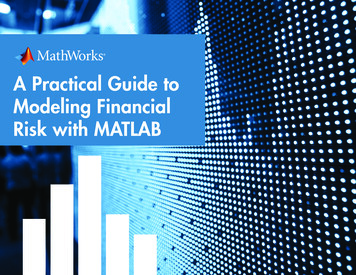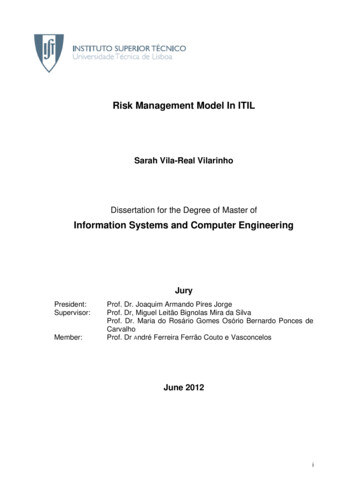
Transcription
FINANCIAL RISK MANAGEMENTThe IMF’s Articles of Agreement call for adequatesafeguards for the temporary use of its resources.1Risks stem from interactions with the membershipin fulfillment of the IMF’s mandate as a cooperative international organization that makes its general resources available temporarily to its members. The IMF has an extensiverisk-management framework in place, including proceduresto mitigate traditional financial risks as well as strategic andoperational risks. The latter risks are addressed by a varietyof processes, including surveillance reviews, lending policiesand operations, capacity building, standards and codes ofconduct for economic policies, the communications strategy,and others.Financial risks are mitigated by a multilayered frameworkreflective of the IMF’s unique financial structure. Key elements include the IMF’s lending policies (program designand monitoring, conditionality and phasing, access policiesas well as the exceptional access framework); investmentguidelines; precautionary balances; internal control structures, financial reporting, and audit systems. In addition,the IMF conducts safeguards assessments of central banksto ensure that their governance and control systems, auditing, financial reporting, legal structures, and autonomy areadequate to maintain the integrity of operations and minimize the risk of any misuse of IMF resources.This chapter provides an overview of the financial riskmanagement framework and control structure of the IMF.A detailed description of financial risk mitigation follows,covering credit, liquidity, income, and market risks (interest rate and exchange rate risk controls). The balance ofthe chapter details the IMF’s strategy for handling overdue financial obligations, safeguards assessments of centralbanks, and the IMF’s audit framework and financial reporting and risk-disclosure mechanisms.6.1 FINANCIAL RISK: SOURCES ANDMITIGATION FRAMEWORKThe monetary character of the IMF and the need for itsresources to revolve require that members with financialArticle I, paragraph V: “To give confidence to members bymaking the general resources of the Fund temporarily available tothem under adequate safeguards, thus providing them with opportunity to correct maladjustments in their balance of paymentswithout resorting to measures destructive of national or international prosperity.”16obligations to the institution repay them as they fall due sothat resources can be made available to other members. TheIMF faces a range of financial risks in fulfilling its mandate,relating to credit, liquidity, income, and market risk, and hasdeveloped a multilayered financial risk-mitigation framework (Box 6.1). Credit risk typically dominates, reflecting the IMF’score role as a provider of balance of payments supportto members when other financing sources may not bereadily available. Credit risk can fluctuate widely sincethe IMF does not target a particular level of lendingor lending growth. While credit risks are inherent inthe IMF’s unique role, it employs a comprehensive setof measures to mitigate those risks and safeguard theresources members provide to the IMF. Related to credit risk is liquidity risk—the risk that theIMF’s resources will be insufficient to meet members’financing needs and its own obligations. Members maymake additional demands for credit and may alsodraw on their reserve tranche positions and draw suddenly and in large amounts from their precautionaryarrangements. In addition, under the terms of the NewArrangements to Borrow (NAB) and borrowing agreements, lenders may encash their claims against theIMF if they face balance of payments difficulties. The IMF also faces income risk—the risk of a shortfallin the ratio of annual income to expenses. This risk hasbeen significant in the past—for example, when lending fell to low levels during the mid-2000s, before therecent global financial crisis. There has been significant progress in implementing the IMF’s new incomemodel, which aims to mitigate these risks. The IMF does not face significant market (exchangerate and interest rate) risk in its lending and fundingoperations with members. The IMF faces market riskson its investment portfolios, though these risks areconstrained by the adoption of relatively conservativestrategies (see Chapter 5).The IMF works to mitigate credit risk in several ways,including through policies on access, limits on financing,and incentives to contain excessively long and heavy use.It also mitigates credit risk through program design andconditionality, safeguard assessments of central banks,post-program monitoring, measures to deal with misreporting, periodic reviews of the adequacy of precautionaryIMF Financial Operations 117
CHAPTER 6Financial Risk Managementbalances, and an arrears strategy. Liquidity risk is managed through regular quota reviews, as well as maintaining a 20 percent liquidity cushion called the prudentialbalance, and implemented through the Forward Commitment Capacity and the Financial Transactions Plan (seeChapter 2).2 In addition, the IMF may borrow temporarily to supplement quota resources. The IMF’s new incomemodel aims to mitigate income risk and fluctuations. Thesections that follow discuss these risk-mitigation factors inmore detail.6.1.1 Credit Risks6.1.1.1 Lending PoliciesCredit risk refers to potential losses on credit outstandingdue to the inability or unwillingness of member countriesto make repurchases (that is, to repay credit extended tothem). Credit risk is inherent in the IMF’s unique role inthe international monetary system given that the IMF haslimited ability to diversify its loan portfolio and generallyprovides financing when other sources are not available to amember. In addition, the IMF’s credit concentration is generally high due to the nature of its lending.The IMF employs a comprehensive set of measures tomitigate credit risk. The primary tools for credit risk mitigation are the strength of IMF lending policies on access—phasing, program design, and conditionality—which arecritical to ensuring that IMF financial support helps members resolve their balance of payments difficulties (seeChapter 2 for a more detailed discussion of the IMF’s lending policies). These policies include assessments of members’ capacity to implement adjustment policies and repaythe IMF including the exceptional access policy for largecommitments. This policy subjects potential users of Fundresources to a higher level of scrutiny, including review ofcompliance with substantive criteria and early involvementof the Executive Board including through a discussion ofrisks to the IMF if access exceeds 200 percent of their quotaannually or 600 percent cumulatively, net of scheduledrepurchases.Credit risks are also mitigated by the structure ofcharges and maturities, and adequate junior cofinancingfrom other official lenders. The IMF passes its low cost offunding to borrowers to assist with their adjustment butadds a level- and time-based surcharge premium to moderate large and/or prolonged use of resources and encourage prompt repayment when access to market financingis restored.Guidelines for Quarterly Financial Transactions Plan: www.imf.org/external/np/tre/ftp/pdf/0408.pdf.2118 IMF Financial OperationsIn addition, the IMF has systems in place to assess safeguard procedures at members’ central banks and to addressoverdue financial obligations. In the event of arrears, theIMF has a strategy for addressing overdue obligations,including a burden-sharing mechanism (Box 6.2). Thismechanism aims to cover income losses related to arrearscharges (see Section 6.2) and also contributes to the accumulation of precautionary balances (see Section 6.1.1.2).Furthermore, the Fund normally employs a system ofpost-program monitoring for closely assessing circumstances and policies of members whose outstanding creditto the General Resources Account exceeds 200 percent oftheir quota following the expiration of their IMF arrangements. Such monitoring aims to give an early warningof policies that could threaten a member’s external sustainability and ability to repay the IMF. It also serves as amechanism for bringing these issues to the attention of thecountry authorities and the Executive Board and for stimulating policy action if warranted by the conditions facingthe member. In other cases, post-program monitoring maybe required even if the country’s outstanding credit is below200 percent of its quota. This occurs if economic developments call into question the country’s progress towardexternal viability.36.1.1.2 Precautionary BalancesPrecautionary balances strengthen the IMF’s balance sheet,help to ensure the value of members’ reserve positions,and safeguard the IMF’s financing mechanism (Box 6.3).IMF financial assistance can result in large exposures, andhigh credit concentration is a likely consequence of theIMF’s mandate to respond to members’ balance of payments needs. Precautionary balances address residual risksafter applying other elements of the multilayered riskmanagement framework and protect the IMF’s balancesheet in the event that it suffers losses as a result of creditor other financial risks (Box 6.1). This function is criticalto protecting the value of members’ reserve assets and promotes confidence that members’ reserve positions are safeand liquid from a balance sheet perspective. Precautionarybalances also help ensure that the IMF meets InternationalFinancial Reporting Standards (IFRS) (Box 6.4).The IMF’s precautionary balances consist of reserves heldin the General and Special Reserves and the balance in the3Post-program monitoring remains in effect until outstandingcredit falls below the threshold of 200 percent of quota. Nonetheless, the IMF’s Executive Board could agree to discontinuethe monitoring—even before outstanding credit falls below thethreshold—if strong policies are in place and the external positionis sound. In cases where post-program monitoring is found to berequired even though outstanding credit is below 200 percent ofquota, the monitoring will normally be carried out for 1 year.
Financial Risk ManagementSpecial Contingent Account, or SCA-1 (Box 6.3).4 Additionsto reserves come through three channels: net income allocations determined annually by the Executive Board (including from surcharges), and contributions from IMF debtorsand creditors under the burden-sharing mechanism, whichare potentially refundable. The IMF conducts regularreviews of the adequacy of precautionary balances.6.1.1.3 Review of the Adequacy of Precautionary BalancesFollowing the accumulation of substantial arrears in themid-1980s, the Executive Board decided that the IMF’sreserve accumulation should be formalized under twoguidelines: (1) Reserves should cover credit outstanding tomembers in protracted arrears. (2) Reserves should includea margin for potential exposure to risk associated with creditin good standing. An indicative target of 3 to 5 percent wasestablished for the latter.At the 2002 review of precautionary balances, a new target was established at SDR 10 billion. This figure took intoaccount a number of considerations, including the possibility of imminent risk to the IMF’s credit portfolio, the needto ensure continued compliance with International FinancialReporting Standards, and the need to raise the IMF’s reserveratio closer to those of other international financial institutions. The IMF staff also considered it reasonable to doubleprecautionary balances to at least 6 percent of the IMF’scredit capacity. The target was subsequently reaffirmed onthree occasions, in 2004, 2006, and 2008.During the 2008 review of precautionary balances, theExecutive Directors asked the IMF staff to develop a moretransparent and rules-based framework for reserve accumulation, with forward-looking elements to account forthe volatility of IMF lending. They noted that this framework should cover how the reserves target would be setand adjusted over time, the modalities for accumulatingreserves, and how reserves in excess of the target would behandled. The Directors emphasized that credit risk shouldbe the primary consideration in assessing reserve adequacyunder the new income model (see Chapter 5), since thismodel is expected to significantly mitigate the IMF’s overall income risk. They also supported use of a variety offorward-looking indicators and further development of scenario analyses and stress tests.In response to this request, the IMF staff proposed a newframework for assessing reserve adequacy in 2010. Underthe framework, the target for precautionary balances wouldFor analytical purposes the IMF’s concept of precautionary balances does not include the portion of the Special Reserveattributed to the gold profits and invested in the endowment. As alegal matter, however, the special reserve forms part of the IMF’sreserves and amounts attributed to gold sales profits may be usedfor the same purposes as other parts of the Special Reserve.4CHAPTER 6be broadly maintained within a range linked to developments in total credit outstanding. The framework consistsof four main elements: Reserve coverage ratio: The reserve coverage ratio wouldbe set within a range of 20 to 30 percent of a forwardlooking measure of credit outstanding, subject to a minimum floor (see below). This proposal draws on approachesof other international financial institutions but seeks toadapt them to the specific circumstances of the IMF. Forward-looking credit measure to anchor the range:The credit measure used to determine the range wouldinclude a strong forward-looking element while alsoseeking to smooth some of the year-to-year volatility ofcredit movement. Specifically, it would comprise a 3-yearaverage of credit outstanding covering the previous12 months and projections for the next 2 years, takinginto account scheduled disbursements and repaymentsunder all approved nonprecautionary arrangements. Treatment of precautionary arrangements: The framework currently does not explicitly include commitmentsunder precautionary arrangements in determination ofthe range, but allows for these commitments to be takeninto account when the Executive Board decides where toset the target. A minimum floor for the target: The frameworkincludes a minimum floor for precautionary balancesto protect against an unexpected increase in credit riskand ensure a sustainable income position.Most Directors supported this framework at the 2010review, and the target for precautionary balances was raisedto SDR 15 billion. Consistent with the framework the targetwas subsequently increased to SDR 20 billion at the timeof the review in April 2012 (Table 6.1) and maintainedunchanged at the most recent review in February 2014.6.1.2 Liquidity RisksLiquidity risk is the risk that the IMF’s resources may notbe sufficient to meet the financing needs of members andits own obligations. The IMF must have adequate usableresources available to meet members’ demand for IMFfinancing. While the IMF’s resources are largely of a revolving nature, uncertainties in the timing and amount of creditextended to members during financial crises expose theIMF to liquidity risk. Moreover, the IMF must also standready to (1) meet, upon a member’s representation of need,demands for a drawing of a member’s reserve tranche position, which is part of the member’s reserves, and (2) makedrawings under borrowing agreements to fund encashmentrequests from lenders under bilateral borrowing agreementsor the New Arrangements to Borrow in case of balance ofpayments need of the relevant creditor member.IMF Financial Operations 119
CHAPTER 6Financial Risk ManagementTable 6.1 Level of Precautionary Balances in the General Resources Account(Billions of SDRs; as of April 30 each year)End of Financial YearPrecautionary balances1ReservesGeneralSpecialSCA-1Free reserves2Memorandum items:Credit outstandingCredit in good standingArrears3PrincipalChargesPrecautionary balances to Credit outstandingFree reserves to Credit in good 0.30.812.812.581.281.01.10.30.815.715.4Source: Finance Department, International Monetary Fund.Note: SCA Special Contingent Account.1Precautionary balances as of the end of FY2011 and for subsequent periods exclude profits from gold sales.2Precautionary balances in excess of arrears on principal.3Obligations to the GRA that are 6 months or more overdue, excludes arrears for Structural Adjustment Facility (SAF) loans. The IMF’s financial structure helps mitigate liquidityrisk, but the volatility and uncertainty in the timing andsize of members’ needs for financing, as well as the potentialdemands from members to draw on their reserve tranchepositions, require appropriate management of that liquidityrisk. The IMF does not use market financing to cover unanticipated liquidity needs, but rather takes a multifacetedapproach to ensure sufficient financial resources to cover itsmembers’ financing needs: The IMF’s main measure of its capacity to make newGRA resources available to its members—the ForwardCommitment Capacity (FCC)—is closely monitoredby the Executive Board, management, and staff. TheFCC equals uncommitted usable resources from quotaand IMF borrowing, plus repurchases 1 year forward,minus repayment on borrowing 1 year forward, minusthe prudential balance (Box 6.5). A modified FCC hasbeen developed to take into account shorter-term availability of resources under the amended and expandedNAB (see Chapter 2). The maximum activation periodwithin which the IMF can make commitments fundedwith NAB resources is 6 months. IMF lending is based on an exchange of assets. Members whose currencies are used in GRA lending operations are reviewed and approved by the ExecutiveBoard on a quarterly basis in the Financial Transactions Plan (FTP). In the FTP, the IMF staff specifies the120 IMF Financial Operationsamount of SDRs and selected member currencies to beused in transfers and receipts expected to be conductedthrough the GRA during that period. The selectionof members to participate in financing IMF lendingtransactions takes into account recent and prospectivedevelopments in balance of payments and reserves,trends in exchange rates, and the size and duration ofexternal debt obligations. Use of the IMF’s holdings ofthese currencies in lending operations results in FTPmembers receiving, in exchange, a liquid claim onthe IMF (reserve tranche position) that earns interestbased on the SDR interest rate.5 The NAB employs aIMF reserve positions, which are part of members’ reserve assets,must be fully liquid and readily available for use if needed. Members’reserve positions at the IMF are the sum of the reserve tranche thatreflects the reserve assets the member has provided to the IMF underits quota-based obligations and use of the member’s currency in theIMF’s lending operations, plus any indebtedness of the IMF in theGRA that is readily available to the member to meet balance of payments financing needs (see Chapter 2). The IMF’s Balance of Payments and International Investment Position Manual, Sixth Edition(BPM6) defines reserve assets as “those external assets that are readily available to and controlled by monetary authorities for meetingbalance of payments financing needs, for intervention in exchangemarkets to affect the currency exchange rate and for other resultedpurposes . . .” To be readily available, reserve assets generally shouldbe of high quality. (See BPM6, Chapter 6, paragraphs 6.64 and 6.70.)5
Financial Risk Managementsimilar quarterly liquidity review called the ResourceMobilization Plan (RMP) (see Chapter 2). Longer-term resource needs are assessed in GeneralQuota Reviews of the adequacy of members’ quotas formeeting the demand for IMF financing that take placeat least every 5 years. The methodology is not definedunder the Articles of Agreement, but the size of theIMF in terms of quota has been assessed historicallyagainst global economic indicators such as GDP, tradeand capital flows, and estimates of members’ needs (seeChapter 2). The IMF may borrow to supplement its quota resources.It has two standing borrowing arrangements—the NewArrangements to Borrow, which is the main backstopfor quota resources, and the General Arrangements toBorrow, which can be used in limited cases. The IMFhas also employed ad hoc bilateral borrowing with official lenders, and may borrow from the private markets,although it has never done so (see Chapter 2). The prudential balance is intended to safeguard theliquidity of creditors’ claims and take account of thepotential erosion of the IMF’s resource base. The prudential ratio of 20 percent set by the IMF’s ExecutiveBoard reflects historical experience and judgments onthe indicative level of uncommitted usable resourcesthat the IMF would normally not use to make financialcommitments (Box 6.5). Level- and time-based surcharges mitigate large andlong use of IMF credit, supporting the revolving natureof IMF resources by providing an incentive to repurchase IMF credit when market access is regained. Commitment fees also help contain risks to the Fund’sliquidity. The current upward sloping fee structure wasintroduced as part of the broader reforms to the GRAlending toolkit in 2009 with the aim of discouragingunnecessarily high precautionary access (see Box 5.3). Access limits are a further element of the Fund’s riskmanagement framework to help preserve Fund liquidity and the revolving character of Fund resources (seeChapter 2).6.1.3 Income RiskThe IMF also faces income risk—the risk of a shortfall inannual income relative to expenses. This risk has occurredat certain times in the past, including when lending fell tovery low levels during the run-up to the global financial crisis. Chapter 5 explains how the IMF generates income tofinance its administrative expenditures, highlighting theways in which the IMF has adapted the financial structureCHAPTER 6in order to broaden its sources of income. The new incomemodel is intended to mitigate income risk associated withdecreased lending and is based on more diverse sourcesof revenue that are appropriate to support the IMF’s mandated broad range of activities. In addition, precautionarybalances—which also generate investment income—addfurther protection to the Fund’s income. Other measures tomitigate income risk include changes in the margin on thebasic rate of charge and surcharges as well as the burdensharing mechanism.6.1.3.1 Interest Rate RiskInterest rate risk is the risk that the future cash flows will fluctuate because of changes in market interest rates. The IMFmitigates interest rate risk primarily by linking the rate ofcharge to the rate of remuneration. To minimize the effect ofinterest rate fluctuations on income, the IMF links the rateof charge directly to the SDR interest rate (and thus to therate of remuneration, which has often been set at 100 percentof the SDR interest rate before burden-sharing adjustments).Interest rate risk related to bilateral borrowings, issuednotes, and borrowings under the enlarged and amendedNAB is limited since claims from drawings are currentlyremunerated at the SDR interest rate. The proceeds fromborrowings are used to extend credit to member countriesat the rate of charge, which is based on the SDR interest rateplus a margin, or to repay borrowings under bilateral borrowing agreements and the enlarged and amended NAB.Interest rate risk on investments is limited by prudentlimits on duration. For investments through the InvestmentAccount Fixed-Income Subaccount and of resources held inthe trust accounts, interest rate risk is managed by limitingthe duration of the investment portfolio to a weighted average effective duration that does not exceed 3 years.Due to its return objective, the investments of the Endowment Subaccount will be exposed to a larger set of risks,including interest rate risk. The conservative and diversified nature of the Endowment Subaccount asset allocation ensures that these risks are limited and balanced. Itsrelatively small size also limits the impact of adverse marketmovements on the IMF’s overall balance sheet.Procedures are in place to periodically review performance of the Investment Account, including the adequacyof risk limits. Within the scope of the investment authorityunder the Articles, the Executive Board endorses the investment objective, strategic benchmark, and main risk controlprocedures for all IA investments through the adoption ofthe Rules and Regulations for the IA.6 Formal agreements6The strategic benchmark was selected based on an analysis ofhistorical returns, as well as on consultations with private bondmanagers and asset managers of international organizations andcertain central banks of IMF members.IMF Financial Operations 121
CHAPTER 6Financial Risk ManagementFigure 6.1 Forward Commitment Capacity: How the IMF Augments Quota Resources through Borrowing,December 1994–March 2014(Billions of SDRs)300Forward Commitment Capacity1250Forward Commitment Capacity with Borrowing20015010050Forward Commitment Capacity without Jun-05Mar-07Dec-08Sep-10Jun-12–50Mar-14220GRA Total Commitments and Credit Outstanding200180160Total Commitments Credit Outstanding Undrawn GRA Balances140120100806040Credit 320Jun-05Mar-07Dec-08Sep-10Jun-12Mar-140Source: Finance Department, International Monetary Fund.Note: GRA General Resources Account.1The Forward Commitment Capacity in 2009 is determined on the basis of ordinary resources only.with managers and custodians bind them to act within theIMF’s risk approach (see Chapter 5).6.1.3.2 Exchange Rate RiskExchange rate risk is the exposure to the effects of fluctuations in foreign currency exchange rates on an entity’s financial position and cash flows. The IMF has no exchange raterisk exposure on its holdings of members’ currencies in theGRA since, under the Articles of Agreement, members arerequired to maintain the value of such holdings in terms of122 IMF Financial Operationsthe SDR. Any depreciation/appreciation in a member’s currency vis-à-vis the SDR gives rise to a currency valuationadjustment receivable or payable that must be settled by themember promptly after the end of the financial year or atother times as requested by the IMF or the member. TheIMF has other assets and liabilities, such as trade receivablesand payables, denominated in currencies other than SDRsand makes administrative payments largely in U.S. dollars,but the exchange rate risk exposure from these other assetsand liabilities is limited.
Financial Risk ManagementCHAPTER 6Table 6.2 The IMF’s Liquidity, 2009–2014(Billions of SDRs; as of April 30 each year)200920102011201220132014End of periodUsable resources1of which: available borrowing to finance pre-NAB commitments2available borrowing to finance pre/post-NAB commitments2available under NAB activations3Less: Undrawn balances under GRA arrangementsPlus: Repurchases due in next 12 monthsLess: Repayments of borrowing due 1-year forwardLess: Prudential balanceEquals: One-year Forward Commitment 2.8113.316.98.339.7264.3Memorandum items, end of period:Flows during the periodNew commitments4PurchasesRepurchasesTotal credit lines under GAB/NABQuotas of members in Financial Transactions PlanGRA credit outstandingActive borrowing arrangements5Outstanding Borrowing by the S ource: Finance Department, International Monetary Fund. Note: Columns may not add up due to rounding.1Usable resources consist of (1) the IMF’s holdings of the currencies of Financial Transactions Plan (FTP) members, (2) holdings of SDRs, and(3) unused amounts under effective credit lines and activated under the New Arrangements to Borrow/General Arrangements to Borrow (NAB/GAB).2Effective April 1, 2013, the Board approved termination of any further drawings under these Fund bilateral borrowing and note purchaseagreements, which were concluded in 2009/2010 prior to activation of the NAB.3Reflects activation of the enlarged NAB for successive 6-month periods since April 1, 2011.4Gross amounts of new commitments not netted for undrawn balances under expired/cancelled arrangements. Include disbursements underEmergency Assistance.5Total amounts made available under active borrowing agreements, including amounts already disbursed: available only for pre-NAB purchases. Investments of the Fixed-Income Subaccount and thetrusts are exposed to very limited exchange rate risk. Theportfolios include securities—Bank for International Settlements (BIS) Medium-Term Instruments and governmentbonds—denominated in the constituent currencies of theSDR based on the weight of each currency in the SDR basket.However, because securities included in the portfolio changein value over time and generate cash flows, the weight of eachcurrency in the portfolio differs slightly from the weights inthe SDR basket, generating some residual exchange rate risk.This risk is mitigated by regular (at least monthly) rebalancing of the portfolio. Regarding the Endowment Subaccount, the impact of foreign exchange volatility is controlledthrough mandatory hedging of part of the assets back
ing, financial reporting, legal structures, and autonomy are adequate to maintain the integrity of operations and mini-mize the risk of any misuse of IMF resources. This chapter provides an overview of the financial risk-management framework and control structure of the IMF. A d











